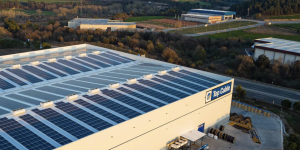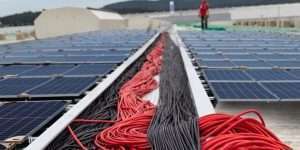Building a quality, safe and profitable solar PV plant with a good return on investment…
Agrivoltaics improves the yield of the solar system
The combination of photovoltaic energy and agricultural production (so called agrivoltaics) is conducive to the yield of the PV system. High temperatures are one of the factors that can affect the performance of a PV project. In this sense, the presence of crops under the panels is a help, as it regulates the temperature and minimises the temperature that the solar system has to withstand. The limitation of crop water evaporation produced by the panels also favours a more favourable climate for the installation.

FACTORS TO BE TAKEN INTO ACCOUNT IN AN AGRIVOLTAIC INSTALLATION
Photovoltaic systems are constantly evolving and expanding. The implementation of agrivoltaics is another example that makes this evident. Although it is not a recent concept, the interest in the implementation of these installations has multiplied in recent years. In agrivoltaic system projects, the area covered by the PV modules is smaller than in the case of traditional ground-mounted PV systems.
The installation costs of an agri-voltaic system depend, to a large extent, on the action required on the ground of the installation. Previous actions are not always necessary, but there are aspects to take into account, such as the need to install the cables at a safe depth of at least one metre to avoid any problems in the agricultural activity to be carried out on the land. This particularity requires a cable that is water resistant, such as the TOPSOLAR® H1Z2Z2-K cable, with the ability to be installed under water (AD8).
The cost of the cables, on the other hand, will not differ depending on the type of project.

DIFFERENT INSTALLATION OPTIONS
Every agricultural project has its own particularities, which is why the variety of installation options offered by this system is so important:
- The most common is to use fixed support systems to install the solar panels about five metres above ground level. This allows the machinery to operate on the agricultural land.
- An alternative installation is dynamic agrivoltaic, which consists of installing the panels on elevated cables. This lighter option allows the position of the panels to be manually adapted according to the season and the portion of land to be cultivated.
- An evolution of this system is the tracking system, which, with the installation of innovative software, moves the panels according to the crop’s growth phase and the weather conditions. This maximises the system’s efficiency and avoids static and permanent shading.
- Finally, solar panels can also be installed on the roof of a greenhouse. In these cases, transparent solar panels with different levels of brightness and transparency are often chosen to allow the light rays and their waves to pass through the panel itself at the optimal intensity for photosynthesis.

In addition to the greenhouse option mentioned above, agricultural installations are recommended for vegetable, fruit, cereal, and vineyard plantations, grazing land for livestock, or, in coastal areas, to feed desalination plants and produce water for crops, livestock, and even human consumption.
THE EUROPEAN UNION IS COMMITTED TO AGRIVOLTAICS
Implementing agroforestry-based crops can greatly help in policies related to energy transition, agriculture, and the environment. It marks a possible path towards meeting the European Green Deal’s (EGD) objectives.
Agro-power systems covering 1% of the agricultural area used at the European level could generate 944 GW of energy, exceeding the European Union’s targets for solar energy generation in 2030 (720 GW).
Aware of these figures, the EU encourages member states to provide incentives through support frameworks to promote agri-voltaics. Information work is needed in rural communities to be aware of their potential to generate clean energy, increase agricultural productivity and contribute to sustainable rural development.
This commitment will be backed by a major event, the annual World AgriVoltaic Conference, to be held in Denver (USA) from 11 to 13 June, for which you can already register.




